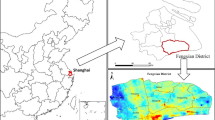Abstract
The occurrence of storm surge disaster is often accompanied with floodplain, overflow, dike breach and other complex phenomena, while current studies on storm surge flooding are more concentrated on the 1D/2D numerical simulation of single disaster scenario (floodplain, overflow or dike breach), ignoring the composite effects of various phenomena. Therefore, considering the uncertainty in the disaster process of storm surge, scenario analysis was firstly proposed to identify the composite disaster scenario including multiple phenomena by analyzing key driving forces, building scenario matrix and deducing situation logic. Secondly, by combining the advantages of k-ω and k-ε models in the wall treatment, a shear stress transmission k-ω model coupled with VOF was proposed to simulate the 3D flood routing for storm surge disaster. Thirdly, risk degree was introduced to make the risk analysis of storm surge disaster. Finally, based on the scenario analysis, four scenarios with different storm surge intensity (100-year and 200-year frequency) were identified in Tianjin Binhai New Area. Then, 3D numerical simulation and risk map were made for the case.
Similar content being viewed by others
References
Xie Cuina. Risk Assessment and Scenario Simulation of Storm Surge in Shanghai Coastal Areas[D]. East China Normal University, Shanghai, China, 2010 (in Chinese).
Zhang Xingnan, Zhang Wenting, Liu Yongzhi. Simulation models of flood inundation due to storm tide[J]. Journal of System Simulation, 2006, 18(S2): 20–23 (in Chinese).
Zhu Junzheng, Yu Pubing. Numerical method for the storm tide overflow model in Hangzhou bay and Qiantangjiang estuary [J]. Advance in Water Science, 2009, 2(2):269–274 (in Chinese).
Xie Changfei. Numerical Simulation of Sea Dikes Breaching Flood by Typhoon Storm Surge[D]. Zhejiang University, Hangzhou, China, 2012 (in Chinese).
Yin Jie, Yi Zhane, Yu Dapeng et al. Flood simulation study of typhoon storm surge based on scenarios Shanghai[J]. Scientia Geographica Sinica, 2013, 33(1):110–115 (in Chinese).
Read M R. Planning through complexity: Employing scenario analysis to facilitate climate change adaptation in fragile states[J]. Climate Change and Fragile States: Rethinking Adaptation, 2012, (16): 110–114.
Yang Gaofeng, Kang Chongqing, Gu Xingkai et al. Scenario analysis based flexibility evaluation of power grid planning under deregulation[J]. Power System Technology, 2006, 30(14):64–70 (in Chinese).
Zhang Ling, Dong Yinhong, Zhang Min. Emergency resource layout decision based on scenario analysis[J]. Systems Engineering, 2014, 32(3):137–142 (in Chinese).
Cañizares Rafael, Irish Jennifer L. Simulation of storminduced barrier island morphodynamics and flooding[J]. Coastal Engineering, 2008, 55(12):1089–1101.
Rosemary A E Smith, Paul D Bates, Christopher Hayes. Evaluation of a coastal flood inundation model using hard and soft data[J]. Environmental Modelling & Software, 2012, 30:35–46.
Fortunato A B, Rodrigues M, Dias J M et al. Generating inundation maps for a coastal lagoon: A case study in the Ria de Aveiro (Portugal)[J]. Ocean Engineering, 2013, 64(2):60–71.
Chen Changsheng, Beardsley Robert C, Westerink Joannes J et al. Extratropical storm inundation testbed: Intermodel comparisons in Scituate, Massachusetts[J]. Journal of Geophysical Research: Oceans, 2013, 118(10):5054–5073.
Zhang Wenting, Zhang Xingnan, Liu Yongzhi et al. Research on windstorm tide flood risk mapping[J]. Journal of Catastrophology, 2007, 22(2):114–118 (in Chinese).
Hu Beibei, Zhou Jun, Wang Jun et al. Risk assessment on storm surge of Tianjin Binhai New Area[J]. Transactions of Oceanology and Limnology, 2012(2): 114–122 (in Chinese).
Zheng Jun. Risk Assessment of Storm Surge and Its application[D]. Zhejiang University, Hangzhou, China, 2011 (in Chinese).
Fang Degou. The Application of Gray and Fuzzy Theory in a Storm Surge Disaster Evaluation [D]. Shanghai Ocean University, Shanghai, China, 2011 (in Chinese).
Zhang Xianglong, Wang Jun, Yang Xinjun et al. Scenario analysis and its application in ecosystem research[J]. Chinese Journal of Ecology, 2008, 27(10):1763–1770 (in Chinese).
Zhang Xingnan, An Ru, Zhang Wenting. Development of flood and waterlogging risk map for Shanghai City[J]. Journal of Hohai University: Natural Sciences, 2005, 33(3):251–254 (in Chinese).
Tong Dawei, Sun Yichao, Sun Ruirui et al. Comprehensive risk analysis of storm surge flood based on WebGIS[J]. Transactions of Tianjin University, 2012, 18(3):194–200.
Zhou Lisha, Yu Xinhua. Fuzzy comprehensive evaluation of power customer satisfaction based on analytic network process[J]. Power System Technology, 2009, 33(17):191–197 (in Chinese).
Sun Bin. Research on Strategy Risk Management Based on Scenario Analysis[D]. Shanghai Jiaotong University, Shanghai China, 2009 (in Chinese).
Wang Xiaoling, Zhang Aili, Zhang Huahong et al. Threedimensional numerical simulation of dam-break flood routing in the complex inundation areas[J]. Journal of Hydraulic Engineering, 2012, 43(9):1025–1041 (in Chinese).
Menter F R. Zonal Two Equation k-? Turbulence Models for Aerodynamic Flows[R]. AIAA-93-2906, 1993.
Wang Xiulian, Tan Guiqiu, Yang Jingquan et al. Research on the numerical calculation of risk degree in flood detention basin[J]. Water Conservancy and Hydropower Express, 2012, 33(12):32–35 (in Chinese).
Wang Xiaolei. Study on Numerical Modeling of Flood Propagation and Flood Loss Assessment of Flood Detention Basin[D]. Agricultural University of Hebei, Baoding, China, 2013 (in Chinese).
Wang Xiaoling, Zhang Aili, Zhang Huahong et al. Threedimensional numerical simulation of dam-break flood routing in the complex inundation areas[J]. Journal of Hydraulic Engineering, 2012, 43(9):1025–1041 (in Chinese).
Soares Frazao S, Zech Y. Dam break in channels with 90° bend[J]. Journal of Hydraulic Engineering, 2002, 128(11):956–968.
Author information
Authors and Affiliations
Corresponding author
Additional information
Supported by the National Basic Research Program of China (“973” Program, No. 2013CB035906), Natural Science Foundation of Tianjin (No. JCYBJC19500) and the Foundation of Innovative Research Groups of National Natural Science Foundation of China (No. 51321065).
Wang Xiaoling, born in 1968, female, Dr, Prof.
Rights and permissions
About this article
Cite this article
Wang, X., Sun, X., Zhang, S. et al. 3D simulation of storm surge disaster based on scenario analysis. Trans. Tianjin Univ. 22, 110–120 (2016). https://doi.org/10.1007/s12209-016-2528-y
Accepted:
Published:
Issue Date:
DOI: https://doi.org/10.1007/s12209-016-2528-y




